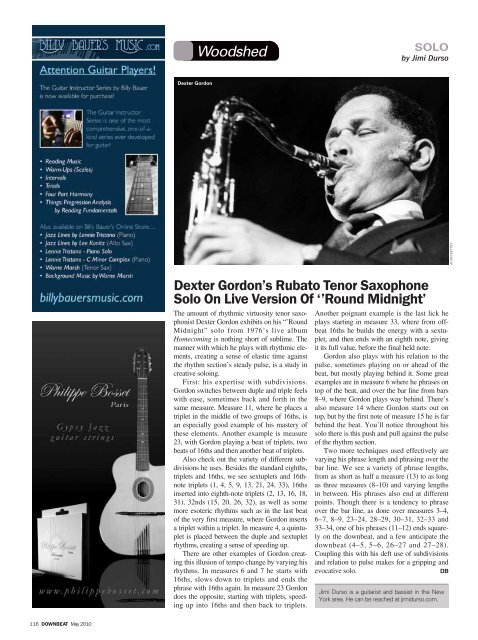Download - Downbeat
Download - Downbeat
Download - Downbeat
- No tags were found...
Create successful ePaper yourself
Turn your PDF publications into a flip-book with our unique Google optimized e-Paper software.
WoodshedSOLOby Jimi DursoDexter GordonALAIN BETTEXDexter Gordon’s Rubato Tenor SaxophoneSolo On Live Version Of ‘’Round Midnight’The amount of rhythmic virtuosity tenor saxophonistDexter Gordon exhibits on his “’RoundMidnight” solo from 1976’s live albumHomecoming is nothing short of sublime. Themanner with which he plays with rhythmic elements,creating a sense of elastic time againstthe rhythm section’s steady pulse, is a study increative soloing.First: his expertise with subdivisions.Gordon switches between duple and triple feelswith ease, sometimes back and forth in thesame measure. Measure 11, where he places atriplet in the middle of two groups of 16ths, isan especially good example of his mastery ofthese elements. Another example is measure23, with Gordon playing a beat of triplets, twobeats of 16ths and then another beat of triplets.Also check out the variety of different subdivisionshe uses. Besides the standard eighths,triplets and 16ths, we see sextuplets and 16thnotetriplets (1, 4, 5, 9, 13, 21, 24, 33), 16thsinserted into eighth-note triplets (2, 13, 16, 18,31), 32nds (15, 20, 26, 32), as well as somemore esoteric rhythms such as in the last beatof the very first measure, where Gordon insertsa triplet within a triplet. In measure 4, a quintupletis placed between the duple and sextupletrhythms, creating a sense of speeding up.There are other examples of Gordon creatingthis illusion of tempo change by varying hisrhythms. In measures 6 and 7 he starts with16ths, slows down to triplets and ends thephrase with 16ths again. In measure 23 Gordondoes the opposite, starting with triplets, speedingup into 16ths and then back to triplets.Another poignant example is the last lick heplays starting in measure 33, where from offbeat16ths he builds the energy with a sextuplet,and then ends with an eighth note, givingit its full value, before the final held note.Gordon also plays with his relation to thepulse, sometimes playing on or ahead of thebeat, but mostly playing behind it. Some greatexamples are in measure 6 where he phrases ontop of the beat, and over the bar line from bars8–9, where Gordon plays way behind. There’salso measure 14 where Gordon starts out ontop, but by the first note of measure 15 he is farbehind the beat. You’ll notice throughout hissolo there is this push and pull against the pulseof the rhythm section.Two more techniques used effectively arevarying his phrase length and phrasing over thebar line. We see a variety of phrase lengths,from as short as half a measure (13) to as longas three measures (8–10) and varying lengthsin between. His phrases also end at differentpoints. Though there is a tendency to phraseover the bar line, as done over measures 3–4,6–7, 8–9, 23–24, 28–29, 30–31, 32–33 and33–34, one of his phrases (11–12) ends squarelyon the downbeat, and a few anticipate thedownbeat (4–5, 5–6, 26–27 and 27–28).Coupling this with his deft use of subdivisionsand relation to pulse makes for a gripping andevocative solo.DBJimi Durso is a guitarist and bassist in the NewYork area. He can be reached at jimidurso.com.116 DOWNBEAT May 2010
















